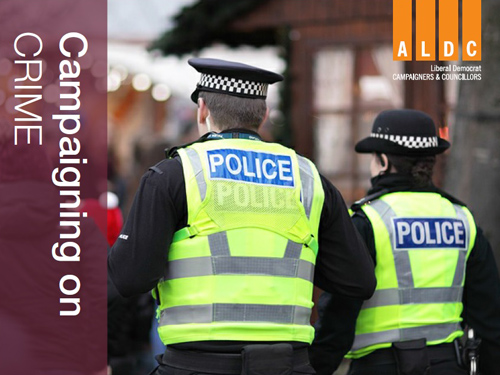
Crime is an issue that is once again on the rise, and from our experiences, is an issue that is coming up more and more on the doorstep.
As part of our campaigning advice, we are relaunching an updated Campaigning on Crime pack today with suggested advice on what you should be campaigning on locally over the next few months.
Before getting going on the campaign, we advise you come up with a plan. Think about:
- Activists – How are you going to involve them in your campaign and encourage them to join you?
- Photos – Do you have a phone bank with pictures near the local police station, graffiti and any officers/ PCSOs?
- Emails – Think about how you are going to share your campaign more widely. Through emails? How are you also going to use the campaign to gather even more emails? As with other forms of communication, try to give opportunities for people to feedback, get in contact with you or even donate (yes, some people really do donate).
- Website – Make sure you have stories launching your campaign and keeping residents up to date. If you are planning on a survey, make sure there is an online version too.
- Door to-door – Everyone knows that getting out on the doorstep and talking to residents is vital and a crime survey is an ideal opportunity to do just this. Make sure you have slots in your diary to regularly canvass, which you can share.
- Literature – How are you going to publicise the campaign? The most recognisable weapon in our armoury is a FOCUS leaflet which has long been used to keep in touch with communities. If you have a police station under threat of closure in your area, this would be a great story for a FOCUS leaflet – and with not much more work it can be easily be turned into a press release. The same issue can be used to create a survey and a petition. And don’t forget direct mail. We have produced a community campaigns checklist which details all the different ways you can communicate about one campaign.
This month we are suggesting two options: some direct mail as well as a survey.
Direct mail
Direct mail should be a staple of every campaign. Not only is it very effective if targeted correctly, it is also read much more widely than any of our usual leaflets, getting our message across to more people about why our candidates are the best choice at election time.
Different people have different issues that are important to them, and whilst a particular issue may be important to one individual or area, it may not matter much to another. So we send individually addressed letters to voters because:
- They allow for a more personal style of communication
- You will get a better response rate
- You can target the message by voter and the issue that they are interested in
- They are better at getting to people in flats or multi-occupation accommodation
- They add variety to your literature – stands out from the rest
Studies by the Direct Mail Information Service show that response rates increase by about 30% if alternative methods of responding (email or phone) are offered as well as postal return. A free-post envelope or return address will also maximise returns.
We have two options: one with a bogus callers card, which you should encourage residents to display and the other containing residents’ briefings on cyber and scam crimes.
Survey
Crime surveys are an easy way of gauging your area’s issues and also introducing our new activists to the canvassing experience.
- It actually engages local residents with issues they care about rather than politics. Obviously, local issues can be very political, but many local residents won’t instantly see them that way.
- Surveys help to get people thinking about other issues that may not be on the survey. You should always include space for people to write about anything else they want to raise, but including questions on specific areas may remind them of what is on their mind.
- Rather than putting people on the spot and hoping they’ll be able to think of any issues that they would like to raise with us whilst we stand on the doorstep, a survey that can be left with them gives them an opportunity to think about it.
- A survey is an opportunity to ask about more issues and gather voting intentions, age, email addresses etc. in a gentler way without having to ask them directly. There are things people may tell you in writing even if they won’t tell you directly on the doorstep. Extra information beyond voting intention is also useful to help you write to people about political issues they may find useful.
- Always include space for people to offer to help through delivering leaflets, joining or doing clerical work.
Do think about the questions you are asking and what you will do with that information going forward – i.e. not just casework, but making sure you keep any residents who take part up to date with any other local crime issues.
Most importantly you can but also share the online survey which you can promote online.
This is an example from my own survey online and well as my Facebook video and MyCouncillor story.
Example reply email from Cheadle Hulme North
A few of us in ALDC offices are doing this on the ground and we want you to join us in the campaign, but to see the whole pack feel free to look ahead here.
We are really keen to have your feedback on the pack. Please let Claire Halliwell know if you have used the pack and if there is anything else which you would like to see for future publications. You can email me directly at claire.halliwell@aldc.org.